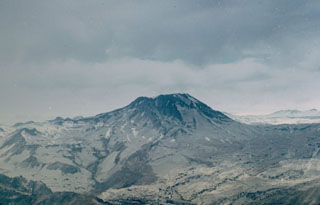Report on Descabezado Grande (Chile) — 2 March-8 March 2022
Smithsonian Institution / US Geological Survey
Weekly Volcanic Activity Report, 2 March-8 March 2022
Managing Editor: Sally Sennert.
Please cite this report as:
Global Volcanism Program, 2022. Report on Descabezado Grande (Chile) (Sennert, S, ed.). Weekly Volcanic Activity Report, 2 March-8 March 2022. Smithsonian Institution and US Geological Survey.
Descabezado Grande
Chile
35.58°S, 70.75°W; summit elev. 3953 m
All times are local (unless otherwise noted)
According to the Buenos Aires VAAC a diffuse cloud of resuspended ash from Descabezado Grande was visible in a satellite data on 8 March.
Geological Summary. Volcán Descabezado Grande is a late-Pleistocene to Holocene andesitic-to-rhyodacitic stratovolcano with a 1.4-km-wide ice-filled summit crater. It lies at the center of a 20 x 30 km volcanic complex, 7 km N of the Cerro Azul stratovolcano. A lateral crater, which formed on the upper NNE flank in 1932 shortly after the end of the major 1932 eruption from nearby Quizapu cone on the N flank of Cerro Azul, was the site of the only recorded eruption. The Holocene Alto de las Mulas fissure on the lower NW flank produced young rhyodacitic lava flows. Numerous small late-Pleistocene to Holocene volcanic centers are located N of the volcano. The northernmost of these, Lengua de Vulcano (or Mondaca), produced a very youthful rhyodacitic lava flow that dammed the Río Lentué.

